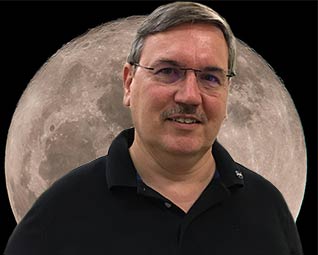

By Tom Campbell
Boötes may well be the most ancient constellation in the sky. It has been recognized by numerous cultures in slightly different forms. The first reference to the name Boötes comes from "The Odyssey" by Homer almost three thousand years ago.
In one of his most popular incarnations, he is called the Hunter and, with his Hounds (Canes Venatici), he eternally circles the Bears, Ursa Major and Ursa Minor, around the North Pole. In fact, the brightest star in Boötes is Arcturus, which can be loosely translated as "Bear Guard."
He is also called the Herdsman and his journey around the pole represents his task of keeping the celestial beasts together.
Another legend says that Boötes was the son of Zeus and Callisto. Hera changed Callisto into a bear who was almost killed by Boötes when he was out hunting. Luckily, she was rescued by Zeus and he took her into the sky where she is now Ursa Major, the Great Bear.
Yet another myth says that he was the son of Demeter, the goddess of agriculture. Supposedly he was given a place in the sky for inventing the plow. The plow is nearby, being pulled by three horses. We know it better today as the Big Dipper.
As you're reading through the list of some of my favorite objects in Boötes below, you'll come across the name William Herschel several times. Frederick William Herschel (1738-1822) was a German-born Brit who built his own large telescope at age 36 and began a systematic study of the night sky.
In his lifetime, he catalogued over 7,500 "new" objects, most of which are in the NGC (New General Catalogue) and IC (Index Catalogue). Even his sister Caroline and his son John got the astronomy bug and made significant contributions of their own.
In 1781, William discovered the planet Uranus. At first, he named it Georgium Sidus, in an attempt to garner financial support from King George III. In France at the time, where the mention of the English king's name was to be avoided whenever possible, the planet was called Herschel. Eventually, it was changed to the name we know and love to joke about today.
Asellus Tertius (κ Boö) is actually a triple star, but one of the components orbits Kappa1 and is too faint and close to detect visually. The stars are only an optical double, however, since proper motion measurements suggest they are moving in different directions. I was barely able to separate the pair at 35X with a 60mm refractor, but anything larger should have no trouble with it. The primary appeared yellow-white and its fainter companion was white.
The name Asellus Tertius is Latin for "third donkey colt." Johann Bayer named the three end stars in the constellation after donkeys for unknown reasons when mapping out Boötes in his famous Uranometria.
Asellus Secundus (ι Boö) (the "second donkey colt") is a pretty binary system. The main star is bright yellow-white and the secondary star is yellow-orange. It is easily resolved with even a modest telescope.
Although the combined light from Pi (p Boö) make it a naked-eye object, it was first observed to be a double star by William Herschel. A nearby 11th magnitude star may also be part of this same system, making it a triple. Both of the main stars are white dwarfs, and close enough together to require a moderate magnification to separate them.
Izar (e Boö) is an Arabic word meaning "veil." Its name is appropriate, as the main star has a tendency to wash out its companion. With an 8-inch Dob, I was able to barely split the pair at 188X. The secondary star is much fainter and somewhat blue-gray. The bright primary is yellow-orange.
The two members of Xi (ξ Boö) orbit one another in a highly elliptical orbit around a barycenter (the center of gravity for the system is somewhere between both stars) and complete one orbit in 151.5 years. Through an 8-inch Dobsonian, it appeared beautiful. The bright primary is yellow-white and the much fainter companion is orange. While the stars are fairly close visually, they are far enough apart to be split at relatively low magnification and the color contrast between them is interesting.
Although not an officially recognized name, Delta (d Boö) is sometimes called Princeps in astrological circles. It's a latin word meaning "prince" or "prime." It is a wide double, perfect for smaller apertures. In an 8-inch Dob, the main star had a yellowish tint to me and the fainter star appeared blue-white. It reminds me of Albireo, exccept the colors aren't as intense.
Alkalurops (μ Boö) comes from a Greek word that means "a herdsman's staff." This is another widely-separated double star, easy in small telescopes. Both stars are white, with one being slightly fainter. Both stars are actually double stars on their own. The primary's double is a mere 0.08 arcseconds away, but the secondary star's companion has a much more manageable 2.2 arcsecond separation.
Discovered by William Herschel in 1784, NGC 5248 is a rather pretty spiral galaxy if you have enough aperture and dark sky to detect the spiral structure.
The Snowglobe (NGC 5466) globular cluster was also discovered by William Herschel in 1784. In an 8-inch Dob under dark skies, it appeared large and round but extremely faint and no individual stars could be detected.
NGC 5557 is an elliptical galaxy discovered by William Herschel in 1785. In a 6-inch reflector from a dark site, it appeared small and faint, not quite round and the center was much brighter.
NGC 5676 is an asymmetrical spiral galaxy. The spiral arms on the south side are twice as long as those on the north side and are fragmented. It was discovered on May 15, 1787 by William Herschel. Noted amateur astronomer Sue French, using a 10-inch reflector, observed the galaxy had an ovalish core, and appeared brighter on one side than the other.
Nearby NGC 5689 is a good example of a lenticular galaxy - one which shows some characteristics of being both spiral and elliptical. This is yet another galaxy first observed by William Herschel in 1787. In a 10-inch reflector, the galaxy resembles a flying saucer UFO. The core's bulge sticks out more towards one side and the center is a little brighter.
| Object | Type | Mag(s) | Dist. (ly) | R. A. | Dec. |
|---|---|---|---|---|---|
| Asellus Tertius (κ Boö) | Double Star | 4.6, 6.6 | 154 | 14h 13.5m | +51° 47' |
| Asellus Secundus (ι Boö) | Double Star | 4.9, 7.5 | 96 | 14h 16.2m | +51° 22' |
| Pi (π Boö) | Triple Star | 4.9, 5.8, 11.0 | 310 | 14h 40.7m | +16° 25' |
| Izar (ε Boö) | Double Star | 2.5, 4.9 | 202 | 14h 45.0m | +27° 04' |
| Xi (ξ Boö) | Double Star | 4.7, 7.0 | 22 | 14h 51.4m | +19° 06' |
| Princeps (δ Boö) | Double Star | 3.5, 8.7 | 122 | 15h 15.5m | +33° 19' |
| Alkalurops (μ Boö) | Quadruple Star | 4.3, 6.5 | 121 | 15h 24.5m | +37° 23' |
| NGC 5248 | Spiral Galaxy | 11.0 | 58,700,000 | 13h 37.5m | +08° 53' |
| Snowglobe (NGC 5466) | Globular Cluster | 9.1 | 51,800 | 14h 05.5m | +28° 32' |
| NGC 5557 | Elliptical Galaxy | 11.9 | 127,000,000 | 14h 18.4m | +36° 30' |
| NGC 5676 | Spiral Galaxy | 12.7 | 100,000,000 | 14h 32.8m | +49° 27' |
| NGC 5689 | Lenticular Galaxy | 12.8 | 99,000,000 | 14h 35.5m | +48° 45' |

About the Author:
Tom Campbell is a software developer, author, and NASA/JPL Solar System Ambassador who is frequetly seen sharing his love of the universe with others.
Website: http://astro.tomandjul.com/

Spring 2023 Newsletter